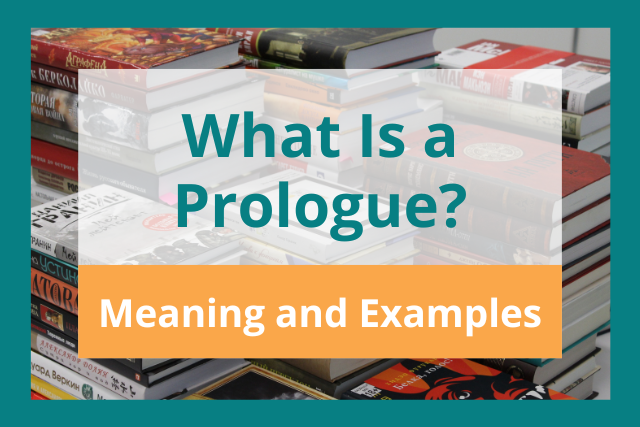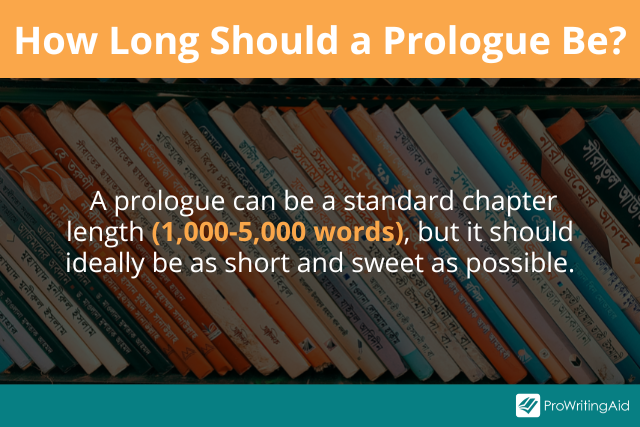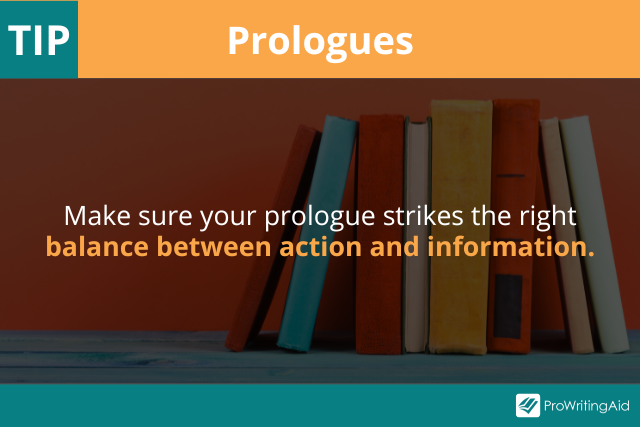
You only get one chance to make a first impression.
Some books make their first impression in the first chapter. Others do so even earlier in the prologue.
So, what is a prologue, and how do you write an effective one?
This article will explain what a prologue is and give you a step-by-step process for writing a great prologue.
Prologue Definition
A prologue is an introductory passage at the beginning of a literary work that is separate from the main narrative.
Prologues exist in plays, novels, movies, and sometimes even poems.
Prologue Meaning
You can think of a prologue as an introductory chapter before the actual story begins.
Not all fiction books have a prologue, but there are many different reasons authors choose to include prologues in their books.

Some novels include a prologue to give the reader important background information about events that take place before the main story begins.
For example, a fantasy novel might use a prologue to tell the reader historical context about the story’s world, so they can understand what’s happening when the story begins.
Other novels use a prologue to establish the tone of the book upfront and show readers what they can expect later in the story.
For example, in thriller books, authors might use an action-packed prologue to foreshadow the exciting events to come, especially if the first chapters are slow.
How Long Should a Prologue Be?
Most novel chapters are around 1,000–5,000 words long.
A good prologue can be the length of a standard novel chapter, but it’s usually better to write a short prologue than a long one.
That’s because the longer a prologue is, the longer it takes the reader to get to the main story. Delaying the start of the real story runs the risk of boring the reader or losing their attention.
If the protagonist doesn’t appear in the prologue, it’s even more important to keep the prologue short because you don’t want to get the reader too invested in a minor side character.
If they get excited about following that character, they might feel disappointed when the book switches to the main character instead.

What’s the Difference Between a Prologue and Other Introductions?
There are many types of book introductions. Prologues, prefaces, and forewords all serve different purposes.
Here’s a quick overview of the difference between these introduction types.
What Is a Prologue vs a Preface?
A preface is an introductory essay written by the author of a nonfiction book.
It’s often the place where the author explains why they’re the right person to write this book. They might mention their education, their teaching experience, their reasons for choosing to write this book, or other similar credentials.
One easy way to tell the difference between a prologue and a preface is that prologues only exist in fiction, while prefaces only exist in nonfiction, particularly in academic writing.
What Is a Prologue vs a Foreword?
Like a preface, a foreword is also an introductory essay at the beginning of a book.
However, a foreword isn’t written by the author of the book. Instead, it’s written by a different expert in the same field to endorse the book and tell readers more about it.
Sometimes fiction books have forewords too, especially if it’s a classic novel that has impacted many people. For example, a new edition of a Jane Austen novel might come with a foreword from a modern author.
What Is a Prologue vs an Epilogue?
An epilogue isn’t an introduction at all—it’s actually the opposite of a prologue.
A prologue is a short chapter that appears at the beginning of a fiction book, while an epilogue is a short chapter that appears at the end.
Epilogues are often used to wrap up the story and create a sense of resolution. For example, it’s common (and even cliché) for romcom epilogues to show the two main characters getting married or engaged to create the feeling of a permanent happy ending.

How to Write a Prologue in 5 Steps
So, now you know what a prologue is, it’s time to figure out how to write one of your own.
What are the exact steps you can take to write a successful prologue?
Step 1: Determine Why You Need a Prologue
It’s important to know why you need to write a prologue, so you can make sure it serves its purpose.
If you don’t have a good reason, it’s better not to write a prologue.
Here are some good reasons to include a prologue:
- There’s crucial information your reader needs to know in order to understand the main story, which can’t be easily incorporated into the rest of the novel.
- You want to give the reader a taste of what to expect from your novel, which can’t be delivered in the first few chapters.
Here are some bad reasons to include a prologue:
- You have a boring first chapter and want to make up for it by adding an exciting prologue. (The better solution to this problem is to write a stronger first chapter.)
- You have a lot of background details you want the reader to know. (The better solution to this problem is to work in that information as it becomes necessary throughout the main story.)
- You think you’re supposed to have a prologue for the type of book you’re writing. (This is just a common misconception—a prologue isn’t a requirement in any genre!)
Step 2: Lead with a Hook
The prologue, just like any great first chapter, should grab the reader’s attention as quickly as possible. Your goal is to convince the reader to keep reading, like reeling in a fish on a hook.
One way to hook readers in is by describing something unusual or mysterious. Prioritize strong visual imagery at the beginning of your prologue.
The hook might be as dramatic as the image of a dead body in a public library. You can hook the reader with these questions: How did the person die? Who will discover them? Why is their body in the library?
Or, the hook might be as mundane as the image of a woman impatiently waiting for a late bus. You can hook the reader in with these questions: Where is the woman going? What is she late for? Will she make it on time?
Make sure you introduce new hooks each time you resolve an existing one, so the reader always has more questions to keep them reading.
Step 3: Balance Action and Information
Whatever you decided in Step 1, it’s important to make sure you accomplish that purpose. However, it’s just as important to strike the right balance between action and information.

Let’s say your goal is to give the reader a piece of information they need in order to understand the main story. Don’t just dump all the information into a dense chunk of text and call it a prologue.
After all, the writing advice “show, don’t tell” applies even to prologues. It’s important to show us what’s happening, instead of just telling us about the characters, the plot, or the world.
One trick is to make sure your prologue includes a character pursuing a goal and encountering an obstacle that prevents them from achieving that goal. This allows you to generate conflict between the character and the obstacle, which creates action.
Step 4: Drop Hints for What’s to Come
A great prologue successfully foreshadows events, characters, or themes that will appear in the main story.
Readers find it satisfying when a detail from the prologue feeds into the main plot later on. This will make the story feel more connected, and it will also reward the reader for paying attention early on.
Step 5: Avoid Extraneous Details
It’s important to keep the prologue short and sweet.
Give the reader all the important details they need to know, but don’t include any extraneous information that isn’t absolutely crucial for the reader’s understanding of the story.
Prologue Examples
Let’s look at some classic examples of successful prologues.
Example 1: Jurassic Park by Michael Crichton
Jurassic Park is a science fiction book about a theme park where dinosaurs break free and attack the humans inside.
This book has two prologues, and each one is effective in a different way
The first prologue is a simple, straightforward passage that summarizes the technology available on Earth by the time this book takes place—namely, the technology that lets scientists recreate dinosaurs.
Even though it’s a bit dry, this first prologue is useful because it gives the reader the background information they need to understand how Jurassic Park can exist.
The second prologue is a short, exciting scene in which a minor character gets attacked by a mysterious monster.
This second prologue is useful because the readers of Jurassic Park are expecting exciting scenes with dinosaurs, but the actual dinosaurs don’t show up many chapters into the story, after the main characters arrive at Jurassic Park.
That’s why this second prologue is so effective. It gives the readers a taste of the excitement they’re looking for, which sets the tone for what will happen after the main characters reach the park.
Example 2: Crazy Rich Asians by Kevin Kwan
Crazy Rich Asians is a romcom about—you guessed it—crazy rich Asians.
The prologue takes place years before the story begins when the male romantic lead, Nick Young, is still a child. He and his family try to check into a luxury hotel in London, only to be turned away because of their race.
Angry at the way they’re being treated, one of his aunts makes a phone call and buys the entire hotel, making herself the new boss of the managers who tried to turn them away.
The prologue establishes how crazy rich Nick’s family is. We get a firsthand look at the sheer amount of wealth and power they have access to.
When the main story starts, the protagonist, Rachel Chu, is dating Nick. However, she has no idea how wealthy Nick’s family really is.
We as the readers are only privy to that information because of the prologue, which makes the first chapters of the book more exciting because we’re already anticipating what might happen when Rachel finds out the truth.
Example 3: Romeo and Juliet by William Shakespeare
Romeo and Juliet is among the most famous of Shakespeare’s plays. It might even be the most well-known play in the entire Western canon.
The prologue of Romeo and Juliet consists of a sonnet that introduces the audience to the setting of the play.
Here are the opening lines of the prologue:
Two households, both alike in dignity,
In fair Verona, where we lay our scene,
From ancient grudge break to new mutiny,
Where civil blood makes civil hands unclean.
These four opening lines introduce the conflict between Romeo’s family and Juliet’s family. The audience understands right away that Romeo and Juliet are star-crossed lovers who can never be together.
Unlike most modern authors, Shakespeare uses the prologue to tell the audience everything that’s going to happen in the play.
The prologue tells us explicitly about the tragic demise of Romeo and Juliet, saying that the death of these two young lovers will finally heal the rift between their two families.
Conclusion on What Is a Prologue?
There you have it—our complete guide for what a prologue is and how to write a good one.
Here’s a quick recap:
- A prologue is an introductory chapter before the actual story begins.
- Prologues are written by the author and exist only in fiction, while prefaces are usually found in nonfiction, and forewords are written by someone other than the author.
- You should only include a prologue in your novel if you know exactly why you need one.
Happy writing!

